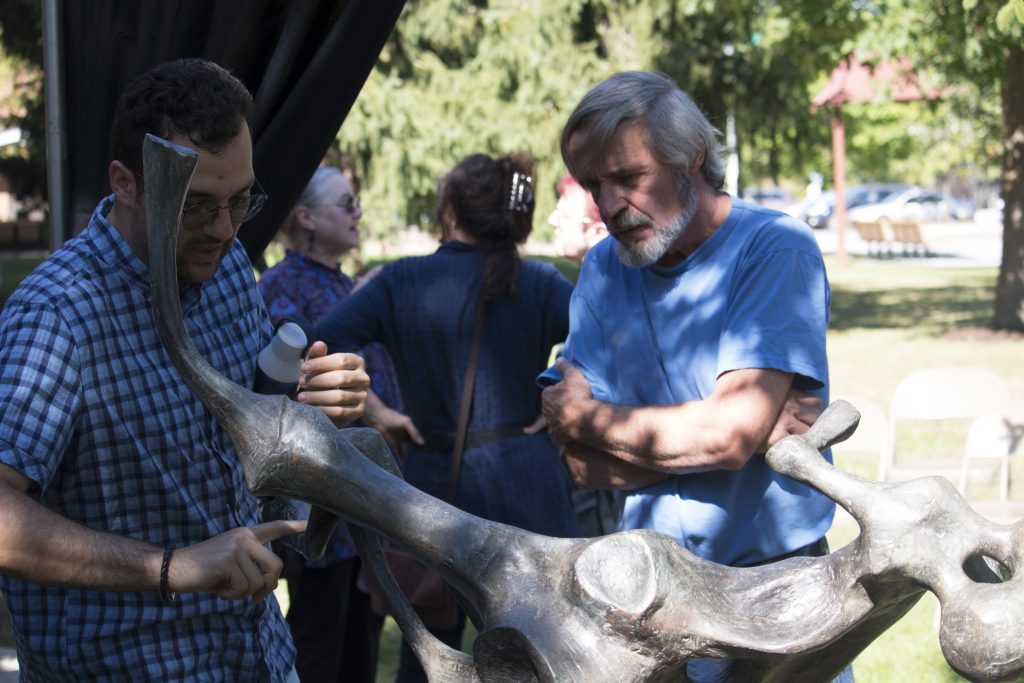The Peace Quad is the new home of a sculpture created by former Binghamton University faculty member Ed Wilson, which was unveiled as a part of an art exhibition at the BU Art Museum in the Fine Arts Building.
The sculpture, titled “Falling Man,” was first installed on campus near Glenn G. Bartle Library in 1973, and was severely damaged after several collisions with snow plows, incidents of student vandalism and overall weather damage. As part of the new “not but nothing other: African-American Portrayals, 1930s to Today” exhibition, the sculpture was unveiled on Saturday morning.
BU President Harvey Stenger said in his unveiling speech that he was excited to see this piece of public art back on BU’s campus.
“Taking care of art is hard,” Stenger said. “No one took care of it. It was great that we had this opportunity — with the new grant that we have, with the new exhibition we’re showing — to stand up this old piece of art, renovating it, bringing it back to its original condition and presenting it to folks here on this Homecoming Weekend.”
Ronald Gonzalez, overseer on the renovation and a professor of art and design, and Jim Spano, ‘78, a freelance visual culture conceptualist from Endicott, said the placement of the sculpture on the Peace Quad hopes to avoid the hazards that decommissioned it in the first place.
“The sculpture can be in close proximity to the Art Museum and in an area where nothing can compete with it too badly,” Gonzalez said. “Also, now we won’t have the same issues with the location.”
Wilson, who passed away in 1997, chaired of the art and design and art history departments at BU. Other works of art by Wilson, including “Cybele,” “Minority Man #1” and a preparatory drawing titled “Study for Minority Man #1,” are also on display at the BU Art Museum. Some of Wilson’s works are featured in other parts of the country, from Baltimore to Downtown Binghamton.
According to Diane Butler, director of the BU Art Museum, visiting “Falling Man” may surprise those who knew the sculpture in the past, since it looks different today.
“It had a different appearance,” Butler said. “When it was repaired, it was also repatinated to be with a little more of a dull finish. It’s very difficult to get the shiny finish back, but also, Ed Wilson was aesthetically in dialogue with Henry Moore, whose sculpture we have in the Memorial Courtyard, and this kind of finish is very Henry Moore-like.”
With the unveiling of “Falling Man” and the exhibition, the BU Art Museum and the Wilson family said they hope to attract community members and students alike to a greater understanding and respect of the minority voice. Craig Wilson, Ed Wilson’s son, said he was grateful for Gonzalez for continuing his father’s work at the University.
“I’m very pleased that Ron Gonzalez has kept up my father’s work throughout the years and restored this sculpture,” Craig Wilson said. “It’s important for this sculpture to be out at the University. It’s important for students to see art and to appreciate it. So, hopefully, this piece can inspire students to come into [the] Fine Arts [Building], or to at least embrace art.”
Other events during the exhibition, which ends on Dec. 7, include a discussion about African American portrayals with Binghamton alumnus Ruben Santiago-Hudson, ‘78, and a community sing-along with Ysaye Maria Barnwell, a former member of the all-female, African American a cappella group, Sweet Honey in the Rock.



